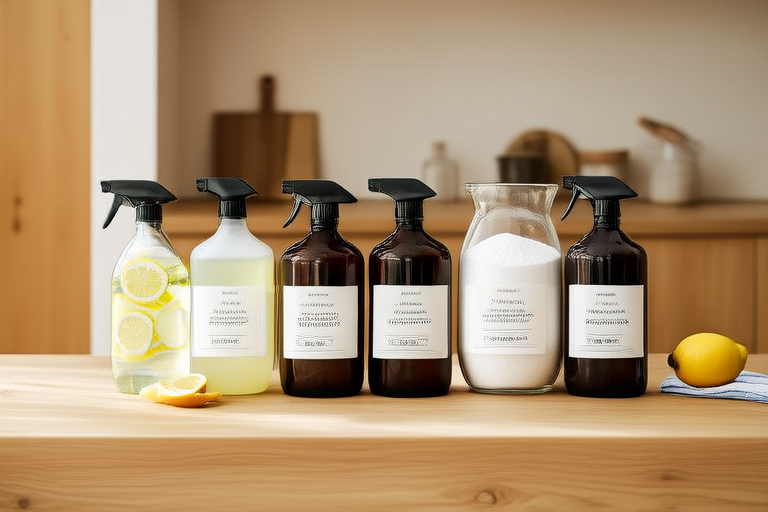DIY Guide: Making Your Own Eco-Friendly Cleaning Solutions at Home
Introduction
In today’s world, where environmental consciousness is on the rise, many people are turning to eco-friendly solutions to reduce their carbon footprint. One of the easiest and most effective ways to contribute to this movement is by making your own cleaning products at home. Not only are these homemade cleaners better for the environment, but they are also safer for you and your family, and can save you money in the long run. In this guide, we will explore how to create your own eco-friendly cleaning solutions using simple ingredients found in your kitchen.
Why Choose Homemade Eco-Friendly Cleaners?
Healthier for You and Your Family
Commercial cleaning products often contain harsh chemicals that can irritate skin, eyes, and respiratory systems. These chemicals can also linger in the air and on surfaces, posing potential health risks, especially for children and pets. By using natural ingredients like vinegar, baking soda, and essential oils, you can avoid these harmful substances and create a healthier living environment.
Better for the Environment
The production, packaging, and disposal of commercial cleaning products contribute significantly to environmental pollution. Many of these products contain non-biodegradable chemicals that can harm aquatic life and contaminate soil. By switching to homemade cleaners, you reduce waste and minimize the release of harmful chemicals into the environment.
Cost-Effective
Making your own cleaning solutions can be much cheaper than purchasing commercial products. The cost of a few basic ingredients can last you for months, and you won’t need to buy expensive bottles or containers. Additionally, many of these ingredients have multiple uses, so you can stretch your budget even further.
Essential Ingredients for Eco-Friendly Cleaners
White Vinegar
Vinegar is one of the most versatile and effective ingredients for cleaning. It is acidic enough to dissolve grease and grime but mild enough not to damage surfaces. You can use it to clean windows, mirrors, floors, and even ovens. Diluted with water, it makes an excellent all-purpose cleaner.
Baking Soda
Baking soda is another multi-functional ingredient. It acts as a gentle abrasive, making it perfect for scrubbing tough stains. It also neutralizes odors and can be used to deodorize carpets, refrigerators, and garbage disposals. When mixed with vinegar, it creates a paste that is great for cleaning drains.
Essential Oils
Essential oils not only add a pleasant scent to your cleaning solutions but also offer additional benefits. For example, tea tree oil has antimicrobial properties, while lemon oil is excellent for cutting through grease. You can choose oils based on their scent preferences or specific cleaning needs.
Castile Soap
Castile soap is a vegetable-based soap that is biodegradable and free from synthetic fragrances and dyes. It works well as a general-purpose cleaner and can be used for washing dishes, laundry, and even as a personal hygiene product. Look for unscented versions if you want to avoid artificial additives.
Step-by-Step Recipes for Homemade Cleaners
All-Purpose Cleaner
- Ingredients: 1 cup white vinegar, 1 gallon warm water, 10 drops of essential oil (optional)
- Instructions:
- Mix the vinegar and water in a large container.
- Add the essential oil if desired.
- Pour the mixture into a spray bottle.
- Shake well before each use.
This cleaner is safe for most surfaces, including countertops, floors, and windows. It effectively removes dirt and grime without leaving any residue.
Glass Cleaner
- Ingredients: 2 cups water, 1/4 cup white vinegar, 1 tablespoon rubbing alcohol, 10 drops of essential oil (optional)
- Instructions:
- Combine the water, vinegar, and rubbing alcohol in a spray bottle.
- Add the essential oil if desired.
- Shake well before each use.
This solution is perfect for cleaning windows and mirrors. It leaves a streak-free finish and is much safer than commercial glass cleaners.
Drain Cleaner
- Ingredients: 1/2 cup baking soda, 1/2 cup white vinegar
- Instructions:
- Pour the baking soda down the drain.
- Follow with the vinegar.
- Let it sit for 15 minutes.
- Rinse with hot water.
This method is effective for clearing clogs and eliminating unpleasant odors. It is gentler on pipes than chemical drain cleaners and won’t release harmful fumes into your home.
Tips for Using Homemade Cleaners
Proper Storage
Store your homemade cleaners in airtight containers away from direct sunlight. Label them clearly to avoid confusion. If you’re using glass bottles, ensure they are childproof.
Testing New Solutions
Before applying a new cleaner to a surface, test it on a small, inconspicuous area first. Some ingredients may react differently with certain materials, so it’s always best to be cautious.
Regular Maintenance
Regular cleaning with eco-friendly solutions can help prevent the buildup of dirt and grime, reducing the need for stronger cleansers. Establish a routine that works for your lifestyle, whether it’s daily, weekly, or monthly.
Conclusion
Creating your own eco-friendly cleaning solutions is a simple yet impactful way to reduce your environmental impact while improving the health and safety of your home. By using common household ingredients, you can make effective and affordable cleaners that are kinder to both the planet and your family. Start small with an all-purpose cleaner and gradually expand your repertoire as you become more comfortable. Remember, every little step counts towards a greener future.
Actionable Steps:
- Try out the all-purpose cleaner recipe and see how it works for your household.
- Replace one commercial cleaner with a homemade alternative each month.
- Share your experiences with friends and family to encourage others to join the eco-friendly cleaning movement.
By taking these steps, you’ll be well on your way to a cleaner, healthier, and more sustainable home.
